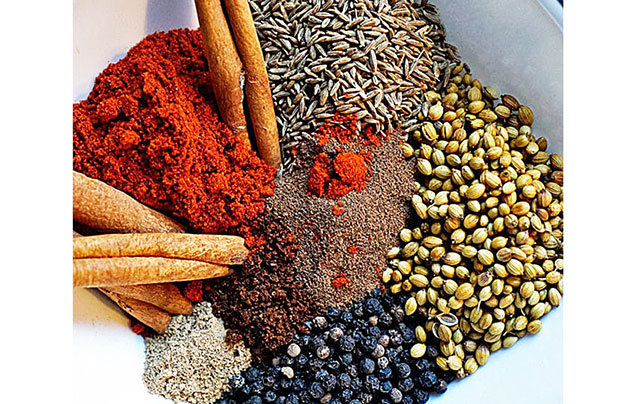Part 1
Can you imagine a life without spices? Just how bland would life be without those little natural artifacts that carry multitudes of tastes, aromas and flavours that we love to add to our food and beverages to make them taste and smell better?
To paraphrase the late John Vorster: “That would be too ghastly to contemplate”. Ice cream without vanilla? Melktert without cinnamon? Jerk without allspice and scotch bonnets? Chai without cloves and cardamom?
To paraphrase someone else: “A task not unlike coming to terms with the Holy Ghost”. That is, if you ask me.
Spices intimidate many people. They have complex tastes and can be used in a bewildering array of combinations. By themselves, most spices do not taste pleasurable or even agreeable. The flavours and aromas contained in spices are chemicals produced by the plants to defend either the whole or part of the plant.
Various parts of the plant could be used as spices: The bark or stems (cinnamon), the roots and other underground stores (ginger and galangal), fruits (black or red pepper), seeds (star anise and caraway), and flowers (cloves and saffron).
There are several ways to classify and cluster spices using their aromas and flavours. They can be: Bitter (clove, cumin and fenugreek), fruity (sumac), citrusy (lemongrass), warming (nutmeg and mace), sulphurous (mustard and garlic), fragrant (juniper berries and coriander), earthy (cumin and saffron), sweet and warming (cumin and cloves), penetrating (cardamom), and so on.
Spices also have secondary functions that include being used in preservatives and in medicine.
Spices are an important component of the terroir of local and regional cuisines. Local climatic and soil conditions determine what grows where and thus what is available for culinary use. Over time, ‘new’ spices originating in different parts of the world were introduced by means of trade, war, slavery, colonialism, occupation and immigration.
This resulted in new spice-driven culinary innovations by blending old, local spices with new, imported ones. The introduction of chillies in South East Asia is one case in point; the Portuguese occupation of the Goa region of India is yet another, and there are of course many, many more.
Here in southern Africa, the introduction of Indian sugar cane workers to South Africa represents one such spicy highlight.
These climatic, socio-political and economic reasons have made it possible to divide the world into fairly distinct macro-regions based on what spices are available and how they are combined, mixed and used.
In the next part of this little series, we’ll look into these regions and the spice mixes that define them.
This week’s recipe comes from Turkey and is a Middle Eastern classic as far as the spices are concerned; few tweaks to one or two ingredients and your baharat could have come from Lebanon or Iraq.
• 2 tablespoons black pepper corns
• 2 tablespoons cumin seeds
• 2 tablespoons coriander seeds
• 1 teaspoon cloves
• 1⁄2 tablespoon cardamom seeds
• 1 tablespoon ground nutmeg
• 1 pinch ground cinnamon
• 1 tablespoon dried mint
Finely ground the whole spices and combine with the rest of the ingredients. Use as indicated or to taste.
• 50 grams bulgar wheat
• 500 grams lamb mince
• 1 small onion, finely chopped
• 1 tablespoon pine nuts
Stay informed with The Namibian – your source for credible journalism. Get in-depth reporting and opinions for
only N$85 a month. Invest in journalism, invest in democracy –
Subscribe Now!










